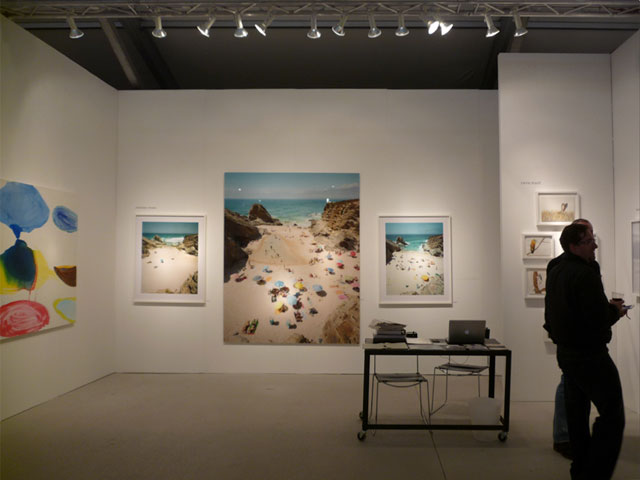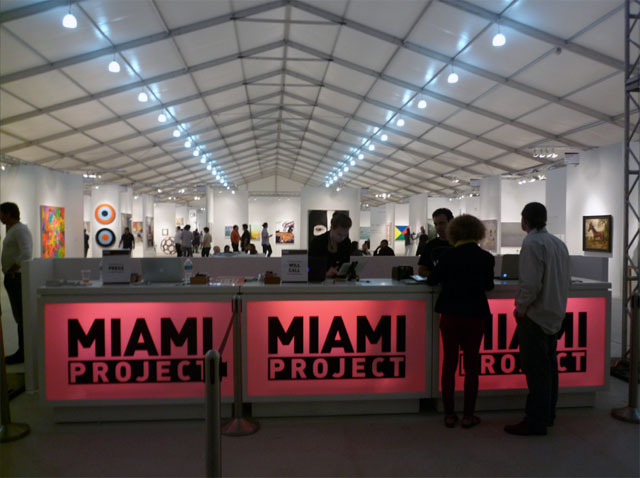Art Basel Miami has a new fair in town, and if Miami Project’s first run is any indication, it will be a player for years to come. That has a lot to do with the fair’s organizers, artMRKT Productions, a company operated by Max Fishko and Jeffrey Wainhause that is known for its fairs in Houston, San Francisco, and the Hamptons. This experience has clearly paid off, as they were able to draw 33 solid exhibitors, and produce a beautiful fair.
Much like UNTITLED, the aisles are wide, the booths are large, and the tent’s lighting is a definite improvement upon what NADA and PULSE have to offer. In fact, the fair has pretty much everything a new fair needs, other than foot traffic and press mentions.
Like most fairs, Miami Project has its share of crap, but it’s kept to a minimum. Kerry Inman, director of Houston-based Inman Gallery, told us that there’s “a little bit of editing” going into what’s shown by each gallery. Inman serves on the fair’s selection committee, and she’s been one of artMRKT’s strongest supporters, participating in the group’s Houston-based iteration, Texas Contemporary, since day one.
Although the gallery’s been in business since 1990, this year marks her first trip eastward to Miami. She’s more than comfortable with that decision, telling us that “[Max Fishko] is the first fair organizer to treat us like a collaborator, not a client, so it was easy for us to jump to this.”
Her story is not unlike those of many other dealers at the fair, who have similarly participated in other artMRKT projects, and would more than gladly return; we can’t remember ever going to a fair in which the organizers’ names were dropped so many times by the exhibitors.
“It’s tight and Max is right on it. And this is from another fair director,” DCKT Contemporary co-owner Ken Tyburski told us. Tyburski spent the last two years working for Merchandise Mart, an organization best known for having bought out the Armory Fair in 2008.

DCKT Contemporary, installation view. DCKT brought some of the gallery's mainstays, like Cordy Ryman. His color-blocked wall-relief, "Baby Drop", is one of the booth's stronger works.
Morgan Lehman and DCKT Contemporary both told us they did Fishko’s Houston fair, which made taking the chance on a new Miami fair feel a little easier. “Choosing these fairs can be incredibly nerve-wracking,” Simon Cole of Cooper Cole told us. “I was considering UNTITLED, but Max [Fishko] has done four other fairs, so that factored into my decision.” Unlike many of the other dealers we spoke to, Cole had never worked with Fishko before.
So far, the risk taken by many of these dealers seems to have paid off. Every gallerist we spoke to told us that they’d seen all the major museum directors and curators come through, as well as an enormous number of collectors. And while some dealers have sold enough to make the fair worth doing again, others were a little more cautious.
“We’ll see how I feel Sunday,” Simon Cole told us, though he’d sold six works in his booth earlier in the day to an out-of-town collector. Meanwhile, Jeffrey Teuton, the Director of Jen Bekman Gallery, boasted he’d sold several works by Carrie Marill and Christian Chaize.
For former PULSE exhibitors such as Teuton, however, there was more than sales informing their choice of fair. “If I sell anything near what I did at PULSE, I’ll stay here,” Daniel Weinberg, owner of Daniel Weinberg Gallery, told us. Weinberg was unhappy with the quality of work being shown at PULSE as well as the exhibition design.
That was just the tip of the iceberg. “New York sucked,” Teuton told us of PULSE. “Me alone in a booth for three days. I’m not doing that again.” Plus, the lights went out last year, and the gallery was relegated to the back section of the fair. This year, Jen Bekman Gallery has a large bright booth near the entrance— of Miami Project.

Jen Bekman Gallery, installation view. Christian Chaize's work, seen in the booth's back wall, had proved popular with collectors.
These differences are really important to dealers. “People forget that I’m the client,” Morgan Lehman co-owner Sally Morgan Lehman told me. “If it’s cold, I text Max and 10 minutes later he’s in my booth. I’m here for five days, so my quality of life is important.”
Given that the fair’s open for nearly a week, that’s necessary for keeping dealers sharp and on the ready. Still, both Tyburski and his partner Dennis Christie looked weary after a long week, with two days left to go.
When I asked whether opening the fair on Tuesday, earlier than most, had helped, Tyburski simply told me that to get the word out, this was how it had to be. “The hours are long but this is how you have to do it starting out,” he clarified, while casually adding that “NADA in its first year ran seven days, Sunday to Sunday.”
Perhaps next year, then, the fair will see more visitors and press mentions than it did this year. They deserve it.



Comments on this entry are closed.